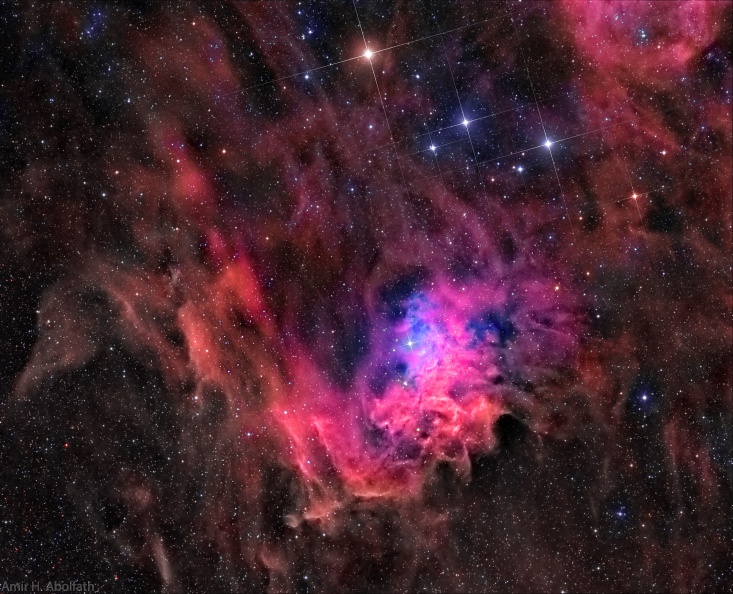
Explanation: Is star AE Aurigae on fire? No. Even though AE Aurigae is named the flaming star, the surrounding nebula IC 405 is named the Flaming Star Nebula, and the region shape gives the appearance of fire, there is no fire. Fire, typically defined as the rapid molecular acquisition of oxygen, happens only when sufficient oxygen is present and is not important in such high-energy, low-oxygen environments such as stars. The material that appears as smoke is mostly interstellar hydrogen, but does contain smoke-like dark filaments of carbon-rich dust grains. The bright star AE Aurigae, visible just to the lower right of the image center, is so hot it glows blue, emitting light so energetic it knocks electrons away from surrounding gas. When a proton recaptures an electron, light is emitted, as seen in the surrounding emission nebula. Featured here, the Flaming Star nebula lies about 1,500 light years distant, spans about 5 light years, and is visible with a small telescope toward the constellation of the Charioteer (Auriga). (APOD)
IC405, Flaming star nebula
H-Alpha:
Optic: Vixen VSD100 at F3.8
Mount: Software Bisque Paramount MX
Camera: SBIG STF8300M
Filters: Baader Ha(7nm)
Guider: SBIG Sti, Orion SSAG
EXP: Ha: 11x900s
Binning: All 1x1
Calibration: Flats, Dark, Bias
CCD Sensor Temp: -20c
Dithering: NO
Software: TheSkyX, ImagesPlus, Registar, PixInsight, Photoshop
Color:
Optic: Vixen VSD100 F3
Mount: Software Bisque Paramoun MX
Camera: Canon EOS6D modified
ISO: 3200
Filters: Bayer filter
Guider: Orion SSAG on 50mm GuideScope
EXP: 50x150s
Software: PixInsight, Photoshop, StarSpikes Pro3
Total integration: 4.85 hours
- Posted on
- Monday 4 March 2019
- Filesize
- 2203 KB
- Visits
- 43309
- Rate this photo
- Software
- Adobe Photoshop CC 2017 (Macintosh)
1 comment
Add a comment